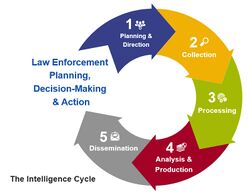Difference between revisions of "Intelligence cycle"
m (Text replacement - "|image=File:" to "|image=") |
|||
| (9 intermediate revisions by one other user not shown) | |||
| Line 8: | Line 8: | ||
|logo_credit = | |logo_credit = | ||
|logo_width = | |logo_width = | ||
| − | |image= | + | |image=IntelcycleIowaversion.jpg |
|image_alt = | |image_alt = | ||
|image_caption = | |image_caption = | ||
| Line 63: | Line 63: | ||
===Planning=== | ===Planning=== | ||
| − | Planning is where policy makers, the Senate Committee for Intelligence, and the President and his aids ask for information to be looked into. | + | Planning is where policy makers, the Senate Committee for Intelligence, and the President and his aids ask for information to be looked into. |
| + | |||
| + | ===Intelligence Requirements=== | ||
| + | |||
| + | Intelligence requirements are defining those questions where intelligence is expected, this is part of threat intelligence where officials will have a listing of intelligence intelligence priorities. Each intelligence organisation will have their own unique information requirements, which refers to information we seek to know. | ||
| + | |||
| + | |||
| + | ====Standing information requirements==== | ||
| + | |||
| + | |||
| + | Standing Information Requirements are intelligence requirements that are on going, and have no end. A requirements that is not simply answered before moving on. | ||
| + | |||
| + | For example, it's an information gap that is always 'standing', and continues to have collection assets tasked to collect and update these requirements. | ||
| + | |||
| + | |||
| + | ====Specific information requirements==== | ||
| + | |||
| + | |||
| + | ====Priority Information Requirements==== | ||
===Collection=== | ===Collection=== | ||
| Line 73: | Line 91: | ||
===Dissemination=== | ===Dissemination=== | ||
| + | ===Failures Of The Intelligence Cycle=== | ||
==See Also== | ==See Also== | ||
A CIA document explaining kids how the cycle works: [[File:Briefing-intelligence-cycle.pdf]] | A CIA document explaining kids how the cycle works: [[File:Briefing-intelligence-cycle.pdf]] | ||
| + | |||
| + | https://www.google.co.uk/books/edition/Intelligence_is_for_Commanders/Su1EAAAAIAAJ?hl=en Google Books page for Intelligence For Officers. | ||
| + | |||
{{SMWDocs}} | {{SMWDocs}} | ||
Latest revision as of 10:11, 17 December 2023
(Military intelligence) | |
|---|---|
 | |
| How the intelligence community handles info. |
The Intelligence Cycle is a set of steps taken by military, law enforcement, and intelligence agencies by decision makers to get the right information to the consumer.
Official narrative
"The traditional Intelligence cycle is the fundamental cycle of intelligence processing in a civilian or military intelligence agency or in law enforcement as a closed path consisting of repeating nodes. The stages of the intelligence cycle include the issuance of requirements by decision makers, collection, processing, analysis, and publication of intelligence. The circuit is completed when decision makers provide feedback and revised requirements. The intelligence cycle is also called the Intelligence Process by the U.S. Department of Defense (DoD) and the uniformed services. The intelligence cycle is an effective way of processing information and turning it into relevant and actionable intelligence.[1]".
Wikipedia calls the 9/11 Commission Report "a result of failures" in this cycle.[2]
Origin
In the 1948 book, Intelligence Is For Commanders by LTC Phillip Davidson and LTC Robert Glass, the use of the word Intelligence Cycle is mentioned.
Concerns
Process
Planning
Planning is where policy makers, the Senate Committee for Intelligence, and the President and his aids ask for information to be looked into.
Intelligence Requirements
Intelligence requirements are defining those questions where intelligence is expected, this is part of threat intelligence where officials will have a listing of intelligence intelligence priorities. Each intelligence organisation will have their own unique information requirements, which refers to information we seek to know.
Standing information requirements
Standing Information Requirements are intelligence requirements that are on going, and have no end. A requirements that is not simply answered before moving on.
For example, it's an information gap that is always 'standing', and continues to have collection assets tasked to collect and update these requirements.
Specific information requirements
Priority Information Requirements
Collection
Processing
Analysis
Dissemination
Failures Of The Intelligence Cycle
See Also
A CIA document explaining kids how the cycle works: File:Briefing-intelligence-cycle.pdf
https://www.google.co.uk/books/edition/Intelligence_is_for_Commanders/Su1EAAAAIAAJ?hl=en Google Books page for Intelligence For Officers.
References
| This is a page stub. Please add to it. |